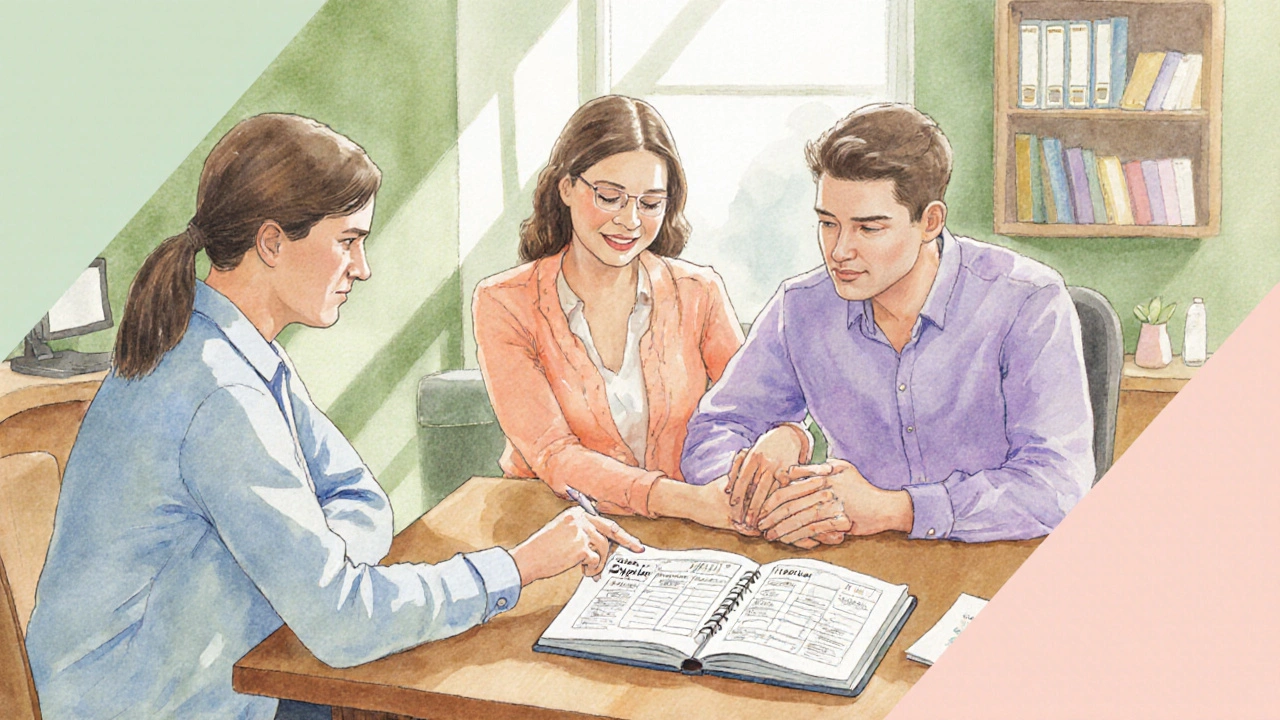Bipolar Relationship Tracker
Track Your Mood Episode
Relationship Insights
Your recent entries show:
Your Relationship Insights
Based on your entries, here's what we've identified:
Your partner may be experiencing financial stress during manic episodes, which aligns with article findings that 45% of couples with bipolar disorder report financial disagreements.
Consider implementing a joint budgeting system with agreed-upon spending limits during manic periods.
Relationship Advice
According to the article, couples who implement a joint treatment plan and regular check-ins experience better outcomes.
When mood episodes occur, try to:
- Use "I" statements to communicate concerns
- Have brief daily check-ins (5-10 minutes)
- Set clear financial boundaries during manic periods
Quick Takeaways
- Manic‑depressive disorder (bipolar disorder) creates distinct challenges during manic and depressive episodes.
- Communication breakdowns often start with mood‑driven misunderstandings.
- Setting clear boundaries, shared treatment plans, and regular check‑ins can protect the bond.
- Professional help - medication, individual therapy, and couples counseling - reduces relapse‑related strain.
- Both partners need self‑care routines to stay resilient over the long haul.
When a partner lives with manic depressive disorder, love can feel like a roller‑coaster. One minute the relationship is buzzing with creative energy, the next it’s weighed down by hopelessness. This article breaks down what’s really happening, why it matters for marriage and intimacy, and what couples can do right now to keep the connection strong.
What is Manic‑Depressive Disorder?
Manic‑depressive disorder is a chronic mental health condition, clinically known as bipolar disorder, that causes extreme mood swings. These swings come in two main forms: manic episodes-periods of high energy, impulsive behavior, and inflated confidence-and depressive episodes-times of deep sadness, low energy, and loss of interest. The disorder typically emerges in late adolescence or early adulthood and affects roughly 1‑2% of the population worldwide.
How Mood Episodes Shape Intimate Relationships
Every relationship has its ups and downs, but bipolar disorder adds a biological rhythm that can amplify the swings. Understanding the two episode types helps partners anticipate and respond more compassionately.
Manic Episodes
During a manic phase, the person with bipolar disorder may become overly talkative, take on many projects, and display risk‑taking behavior. While this surge can feel exciting, it often leads to:
- Spending sprees that strain joint finances.
- Impulsive sexual or social activities that trigger jealousy or insecurity.
- Reduced sleep, causing the partner to take on extra caretaking duties.
These patterns can erode trust if left unchecked.
Depressive Episodes
When the mood flips, the same partner may withdraw, lose interest in intimacy, and struggle with daily tasks. Common relational fallout includes:
- Feelings of abandonment by the non‑affected spouse.
- Increased conflict over chores and responsibilities.
- Loss of shared activities, which can deepen emotional distance.
Depression often fuels self‑blame, making the affected partner think they’re a burden.

Key Relationship Stressors Linked to Bipolar Disorder
Research from the Australian Institute of Family Studies (2023) shows that couples where one partner has bipolar disorder report higher rates of:
- Communication breakdowns (58%).
- Financial disagreements (45%).
- Sexual dissatisfaction (39%).
These stressors aren’t inevitable, but they become more likely when the couple lacks a shared coping roadmap.
Practical Strategies for Couples
Below are concrete steps that help partners ride the mood wave together rather than being swept away by it.
1. Create a Joint Treatment Plan
Medication-usually mood stabilizers such as lithium, lamotrigine, or atypical antipsychotics-forms the foundation of symptom control. Both partners should:
- Know the prescribed dosage and schedule.
- Track side effects in a shared journal.
- Set reminders for doctor appointments.
When the treatment plan is transparent, the non‑affected spouse feels less like a caretaker and more like a teammate.
2. Prioritize Open, Non‑Judgmental Communication
Communication is the glue that holds a relationship together, especially when emotions run high. Use "I" statements (e.g., "I feel worried when bills pile up") rather than blame‑laden language. Schedule brief check‑ins-10minutes once a day-so concerns surface before they explode.
3. Set Boundaries Around Risky Behaviours
During mania, the affected partner may feel invincible. Agree ahead of time on limits for spending, substance use, or impulsive travel. Write the limits down and revisit them weekly.
4. Build a Support System Outside the Couple
Both partners benefit from external anchors. This can include family, close friends, or support groups for partners of people with bipolar disorder. Sharing experiences reduces isolation and provides fresh perspective.
5. Maintain Physical and Emotional Intimacy
Sexual desire often fluctuates with mood. Instead of expecting a fixed level of intimacy, discuss comfort levels openly. Simple gestures-holding hands, cuddling while watching a favorite show-help sustain a sense of closeness even when sexual drive dips.
6. Use Professional Help Early
Therapy isn’t just for crises. Couples therapy provides a neutral space to practice communication skills and negotiate boundaries. Cognitive‑behavioral therapy (CBT) for the individual can also teach coping tools that ripple into the relationship.
Comparing Relationship Dynamics: Manic vs Depressive Episodes
| Aspect | Manic Phase | Depressive Phase |
|---|---|---|
| Energy Level | Hyper‑active, may take on multiple projects simultaneously | Low, often needs help with daily tasks |
| Communication Style | Rapid, sometimes overwhelming; may jump topics | Withdrawn, short replies, may avoid discussions |
| Financial Behavior | Spontaneous spending, risk‑taking investments | Neglect of bills, reliance on partner for money management |
| Intimacy | Increased libido but often impulsive | Reduced desire, need for emotional reassurance |
| Stress Triggers | Sleep deprivation, criticism of grand ideas | Perceived neglect, feelings of uselessness |

When to Seek Professional Help
If any of the following situations appear, it’s time to call a mental‑health professional:
- Episodes lasting longer than two weeks without improvement.
- Repeated hospitalizations or suicidal thoughts.
- Severe financial loss or legal trouble caused by impulsive actions.
- Persistent breakdown in communication despite attempts to set boundaries.
Early intervention reduces the risk of long‑term relational damage and improves overall quality of life.
Self‑Care Tips for the Non‑Affected Partner
Supporting someone with bipolar disorder can be draining. To stay resilient:
- Schedule regular “me time”-exercise, hobbies, or quiet reading.
- Connect with a peer‑support group like the Australian Bipolar Support Group (ABSG).
- Set realistic expectations; you can’t fix every mood swing.
- Consider individual counseling to process your own feelings.
Resources and Further Reading
Below are reputable sources for deeper learning:
- National Institute of Mental Health (NIMH) - Bipolar Disorder Fact Sheet.
- Beyond Blue - Guides for partners of people with mental illness.
- Australian Government - Medicare benefits for psychiatric care.
- Books: “The Bipolar Relationship” by Julie Fast and “Loving Someone with Bipolar” by Julie A. Fast.
Frequently Asked Questions
Can bipolar disorder be cured?
Bipolar disorder is a chronic condition, meaning it can be managed but not cured. Consistent medication, therapy, and lifestyle adjustments can dramatically reduce episode frequency and severity.
How often should a couple have “check‑in” talks?
A brief daily check‑in (5‑10minutes) works well for most couples. If episodes are frequent, consider a longer weekly session focused on planning and boundary review.
Is it safe for the non‑affected partner to take medication?
Partners do not need psychiatric medication unless they have their own diagnosis. However, anti‑anxiety supplements like magnesium or B‑vitamins can be discussed with a doctor for stress relief.
What signs indicate a manic episode is starting?
Early warnings include decreased need for sleep, racing thoughts, exaggerated confidence, and rapid spending. Noticing these cues helps the partner intervene early.
How can finances be protected during manic phases?
Set joint budgeting apps with password protection, limit credit‑card access, and create a prepaid “fun” allowance that satisfies impulsivity without jeopardizing essential bills.

Laura Barney
October 14, 2025 AT 18:52Manic‑depressive disorder can feel like a roller‑coaster painted with neon lights and sudden shadows. The manic highs bring a burst of creative energy that can be exhilarating for both partners. Yet the crashing lows often leave the relationship in a fog of doubt and withdrawal. It’s essential to keep communication bright and honest, even when the mood swings feel like a storm. Setting shared rituals can act as a steady lighthouse amid the turbulence.
Jessica H.
October 19, 2025 AT 09:59From a clinical perspective, the article correctly identifies the prevalence of financial disagreements among couples dealing with bipolar disorder. However, it fails to emphasize the necessity of a legally binding financial plan in cases of severe manic impulsivity. The omission of risk mitigation strategies such as joint account safeguards weakens the practical applicability of the advice. Furthermore, the language used in the piece could benefit from greater precision to avoid misinterpretation. Overall, the content is informative but lacks comprehensive preventative measures.
Tom Saa
October 24, 2025 AT 01:05One might contemplate the dialectic between the self and the other when mood oscillates so dramatically. The phenomenology of mania can be construed as an expansion of the ego, whereas depression contracts it. In relational terms, this oscillation resembles a tidal rhythm that reshapes the shoreline of intimacy. Recognizing this pattern allows partners to adopt a stance of compassionate observation rather than reactionary control. Consequently, the relational fabric can be woven with threads of patience and insight.
John Magnus
October 28, 2025 AT 15:12When dissecting the neurobiological substrate of bipolar disorder, one must consider the dopaminergic surge during manic phases and its impact on reward circuitry. This hyperdopaminergic state frequently precipitates risk‑taking behaviors, such as impulsive spending, which can destabilize joint financial frameworks. Conversely, the serotonergic deficit observed in depressive episodes contributes to psychomotor retardation, often resulting in the affected partner becoming a passive recipient of household responsibilities. The resultant asymmetry in role allocation can amplify relational stressors, particularly when communication pathways are compromised. Recent meta‑analyses demonstrate that couples who engage in structured psychoeducation exhibit a 37% reduction in conflict frequency. Moreover, integrating mood‑tracking applications facilitates real‑time data sharing, thereby enabling preemptive interventions before maladaptive patterns solidify. It is imperative that clinicians prescribe a multimodal treatment plan, encompassing mood stabilizers, cognitive‑behavioral strategies, and conjoint therapy sessions. Financial safeguards, such as joint budgeting platforms with restricted access during manic spikes, serve as a pragmatic contingency. On the affective front, couples are encouraged to cultivate non‑sexual forms of intimacy, such as synchronized breathing exercises, to maintain connection during depressive troughs. The literature also underscores the value of sleep hygiene protocols, as sleep disruption is a well‑documented trigger for both poles of mood dysregulation. In practice, establishing a shared sleep schedule, complemented by blue‑light mitigation, can attenuate the amplitude of mood swings. Additionally, partners should be educated on the early warning signs-decreased need for sleep, racing thoughts, and heightened irritability-to initiate early clinical consultation. The integration of these evidence‑based modalities not only mitigates relational discord but also enhances overall quality of life for both individuals. Finally, ongoing assessment of treatment adherence via periodic blood level monitoring ensures pharmacological efficacy and reduces relapse potential. By adopting a comprehensive, data‑driven approach, couples can transform the volatility of bipolar disorder from a destructive force into a manageable, albeit challenging, aspect of their shared journey.
Marc Clarke
November 2, 2025 AT 06:19I echo the sentiment about establishing clear financial boundaries. A simple joint budget can act as a safety net during manic surges.
angelica maria villadiego españa
November 6, 2025 AT 21:25The emotional roller‑coaster you describe can be overwhelming, but remember you’re not navigating it alone. Small daily check‑ins can ground both partners and prevent misunderstandings. It’s also helpful to celebrate the calm moments, as they reinforce the positive aspects of the relationship. Keep leaning on each other while maintaining personal self‑care.
Ted Whiteman
November 11, 2025 AT 12:32Mania is like a fireworks display-bright, brief, and leaving a mess.
Dustin Richards
November 16, 2025 AT 03:39The dual nature of bipolar disorder necessitates both empathy and boundary setting. I recommend formalizing a crisis plan that outlines who contacts the psychiatrist and what steps to follow. This reduces ambiguity during high‑stress episodes.
Vivian Yeong
November 20, 2025 AT 18:45While the article offers useful suggestions, it overlooks the fact that not all couples have access to therapy resources. The recommendations could be more inclusive by addressing low‑cost alternatives. Otherwise, the guidance feels somewhat privileged.
Reynolds Boone
November 25, 2025 AT 09:52Observing the patterns of mood‑driven financial stress can reveal predictive markers for upcoming episodes. Incorporating this insight into weekly planning empowers both partners to act proactively. The data‑driven approach aligns well with contemporary therapeutic models.
Angelina Wong
November 30, 2025 AT 00:59Great summary of the key takeaways. Implementing brief daily check‑ins can make a noticeable difference.
Anthony Burchell
December 4, 2025 AT 16:05Honestly, the whole “joint budgeting” thing sounds like police state control to some. But if you flip the script and see it as a partnership exercise, it actually fosters trust. Still, don’t let the paperwork drown the romance. Keep the humor alive, even when the mood swings are absurd.
Michelle Thibodeau
December 9, 2025 AT 07:12Let me paint a picture for you: imagine a garden where each flower represents a facet of a relationship-trust, intimacy, communication, and shared dreams. When bipolar disorder enters the scene, it can be likened to a sudden, unseasonal storm that hurls rain, wind, and occasional thunderbolts across the garden. Some blossoms may be battered, their petals bruised by the intensity of manic exhilaration, while others wilt under the heaviness of depressive clouds. Yet, just as a skilled gardener knows, a storm does not have to spell the end of the garden’s beauty. By planting resilient roots-meaning a solid treatment plan, consistent therapy, and honest daily dialogues-the couple can weather the tempest and even emerge stronger. One effective technique is the “shared sunrise ritual,” where each morning the partners briefly outline the day’s priorities, fostering a sense of unity before the mood tides shift. Additionally, incorporating a “financial fence” with predetermined spending caps during manic peaks can protect the garden’s soil from being eroded by impulsive expenditures. It is also vital to sow moments of intimacy that are not solely dependent on libido; simple gestures such as a hand‑held walk or a shared cup of tea can nourish the blossoms of connection during depressive low‑lands. Remember, the garden thrives on diversity-so embracing both the vibrant bursts of creativity that may accompany mania and the reflective calm of depression can add depth to the relational landscape. Ultimately, the key lies in cultivating patience, maintaining open channels of communication, and allowing both partners to tend to the garden together, ensuring that even after the fiercest storm, the blossoms can once again bask in the light.
Patrick Fithen
December 13, 2025 AT 22:19I love the garden metaphor and think it captures the emotional climate well. It reinforces the need for shared rituals.
Michael Leaño
December 18, 2025 AT 13:25Staying optimistic really does help, especially when you celebrate the small wins together. Even a quick evening walk can lift the mood. Keep encouraging each other to seek help when needed.